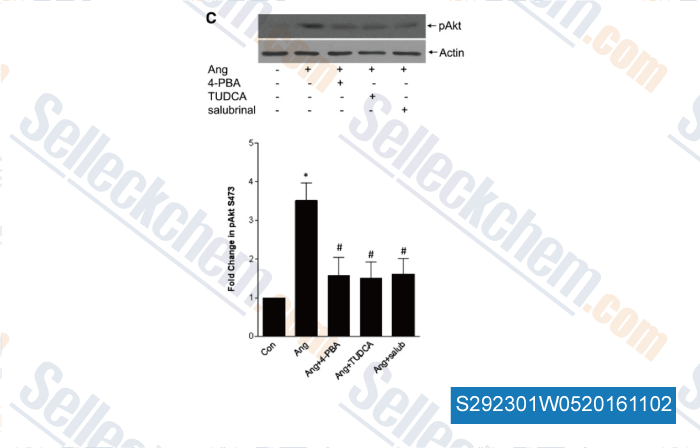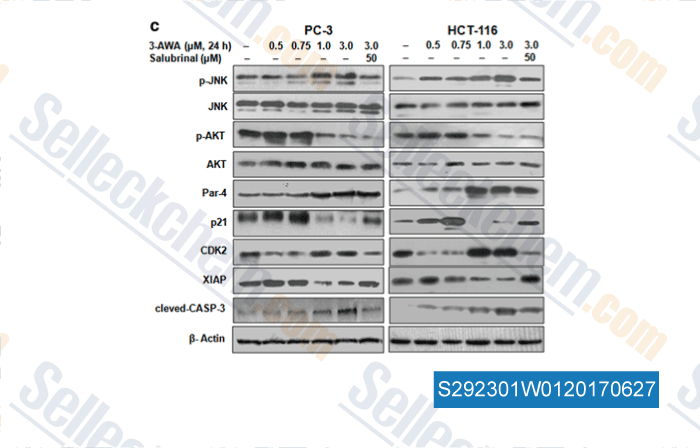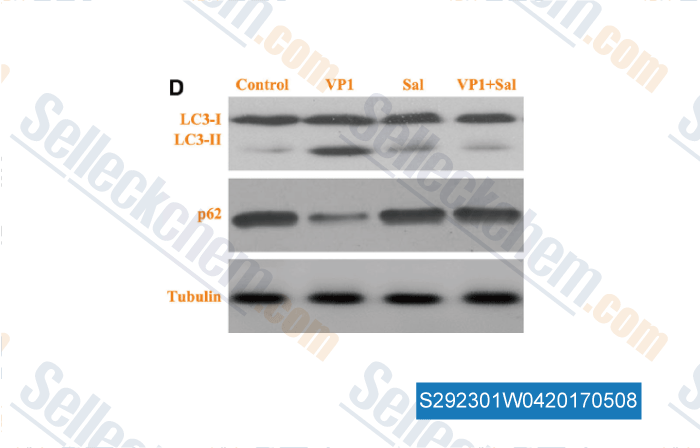|
Toll Free: (877) 796-6397 -- USA and Canada only -- |
Fax: +1-832-582-8590 Orders: +1-832-582-8158 |
Tech Support: +1-832-582-8158 Ext:3 Please provide your Order Number in the email. |
Technical Data
| Formula | C21H17Cl3N4OS |
|||
| Molecular Weight | 479.81 | CAS No. | 405060-95-9 | |
| Solubility (25°C)* | In vitro | DMSO | 95 mg/mL (197.99 mM) | |
| Ethanol | 2 mg/mL (4.16 mM) | |||
| Water | Insoluble | |||
|
* <1 mg/ml means slightly soluble or insoluble. * Please note that Selleck tests the solubility of all compounds in-house, and the actual solubility may differ slightly from published values. This is normal and is due to slight batch-to-batch variations. * Room temperature shipping (Stability testing shows this product can be shipped without any cooling measures.) |
||||
Preparing Stock Solutions
Biological Activity
| Description | Salubrinal is a selective inhibitor of eIF2α dephosphorylation and inhibits ER stress-mediated apoptosis with EC50 of ~15 μM in a cell-free assay. | |
|---|---|---|
| Targets |
|
|
| In vitro | Salubrinal is a selective inhibitor of cellular complexes that dephosphorylate eukaryotic translation initiation factor 2 subunit α (eIF2α). Salubrinal inhibited ER stress-mediated apoptosis induced by the protein glycosylation inhibitor tunicamycin (Tm) in a dose-dependent manner, with a median effective concentration (EC50) ∼ 15 μM. Salubrinal also suppressed Tm-induced DNA fragmentation the processing of caspase-7, a caspase activated by ER stress. However, Salubrinal is not a general apoptosis inhibitor. Salubrinal induced rapid and robust eIF2α phosphorylation and its downstream effects in PC12 cells, including down-regulation of cyclin D1 and up-regulation of GADD34 and CHOP, two proteins whose expression is induced by eIF2α phosphorylation. Salubrinal inhibits eIF2α dephosphorylation by inhibiting the PP1/GADD34 complex. Salubrinal inhibits HSV replication with IC50 of ~ 3μM by inhibiting eIF2α dephosphorylation. [1] Salubrinal increased non-rapid eye movement (NREM) sleep. [2] |
|
| In vivo | Salubrinal inhibits HSV replication in a mouse cornea infection model. Compared to vehicle control, topical Salubrinal treatment significantly reduced the viral titer recovered from eye swabs of infected animals. [1] I.C.V. administration of Salubrinal significantly modified the homeostatic sleep response. [3] |
Protocol (from reference)
| Cell Assay: |
|
|---|---|
| Animal Study: |
|
References
|
Customer Product Validation

-
, , J Am Soc Nephrol, 2015, 26(8):1839-54.

-
Data from [Data independently produced by , , Oncogenesis, 2017, 6(5):e341]

-
Data from [Data independently produced by , , Neurotox Res, 2017, 31(2):204-217]
Selleck's Salubrinal has been cited by 39 publications
| Palmitate induces integrated stress response and lipoapoptosis in trophoblasts [ Cell Death Dis, 2024, 15(1):31] | PubMed: 38212315 |
| GDF15 ameliorates sepsis-induced lung injury via AMPK-mediated inhibition of glycolysis in alveolar macrophage [ Respir Res, 2024, 25(1):201] | PubMed: 38725041 |
| Multiplex single-cell chemical genomics reveals the kinase dependence of the response to targeted therapy [ Cell Genom, 2024, 4(2):100487] | PubMed: 38278156 |
| Neurotransmitter release progressively desynchronizes in induced human neurons during synapse maturation and aging [ Cell Rep, 2023, 42(2):112042] | PubMed: 36701235 |
| Lovastatin Treatment Inducing Apoptosis in Human Pancreatic Cancer Cells by Inhibiting Cholesterol Rafts in Plasma Membrane and Mitochondria [ Int J Mol Sci, 2023, 24(23)16814] | PubMed: 38069135 |
| Nuclear fragile X mental retardation-interacting protein 1-mediated ribophagy protects T lymphocytes against apoptosis in sepsis [ Burns Trauma, 2023, 11:tkac055] | PubMed: 36873287 |
| Hesperadin suppresses pancreatic cancer through ATF4/GADD45A axis at nanomolar concentrations [ Oncogene, 2022, 10.1038/s41388-022-02328-4] | PubMed: 35551503 |
| PARP1 Might Substitute HSF1 to Reactivate Latent HIV-1 by Binding to Heat Shock Element [ Cells, 2022, 11(15)2331] | PubMed: 35954175 |
| Neurodegeneration Risk Factor, EIF2AK3 (PERK), Influences Tau Protein Aggregation [ J Biol Chem, 2022, S0021-9258(22)01264-9] | PubMed: 36563857 |
| Pazopanib restricts small cell lung cancer proliferation via reactive oxygen species-mediated endoplasmic reticulum stress [ Thorac Cancer, 2022, 13(17):2421-2428] | PubMed: 35866204 |
RETURN POLICY
Selleck Chemical’s Unconditional Return Policy ensures a smooth online shopping experience for our customers. If you are in any way unsatisfied with your purchase, you may return any item(s) within 7 days of receiving it. In the event of product quality issues, either protocol related or product related problems, you may return any item(s) within 365 days from the original purchase date. Please follow the instructions below when returning products.
SHIPPING AND STORAGE
Selleck products are transported at room temperature. If you receive the product at room temperature, please rest assured, the Selleck Quality Inspection Department has conducted experiments to verify that the normal temperature placement of one month will not affect the biological activity of powder products. After collecting, please store the product according to the requirements described in the datasheet. Most Selleck products are stable under the recommended conditions.
NOT FOR HUMAN, VETERINARY DIAGNOSTIC OR THERAPEUTIC USE.
